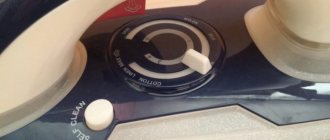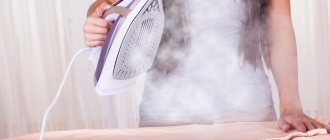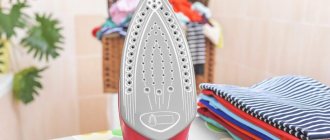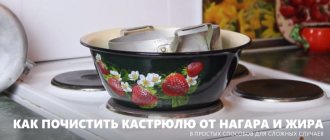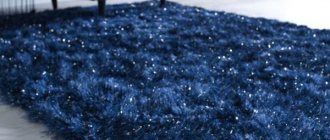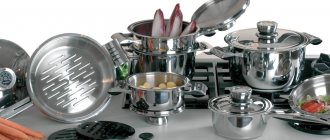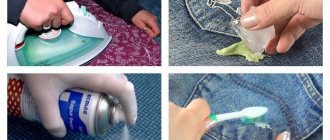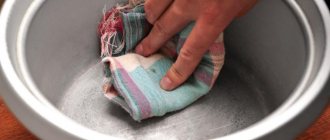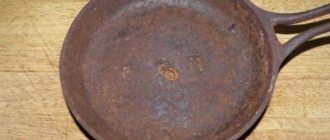One careless movement during ironing - and the aesthetic appearance of the item is instantly ruined. If you choose the wrong heat treatment mode, hold the device on the surface of the fabric a little longer than expected, and iron stains appear - white, brown, glossy, shiny.
They make the product unsuitable for wear or further use, but the situation can be corrected. You can remove marks from careless ironing on clothes using products that are always at hand at home.
Types of iron coatings
Before dealing with dirt, it is necessary to determine what the sole of the device is made of, otherwise you can ruin the surface.
The coatings are as follows:
- Titanium;
- Enameled;
- Aluminum;
- Ceramic;
- Made from stainless steel.
If the coating of the iron is damaged, it will perform its functions worse or become unsuitable for use.
Titanium coated sole
The most expensive but durable material for making iron soles. It is not subject to mechanical stress, does not burn, and takes a long time to heat up. The advantage of titanium coating is that when cleaning it, you can use soft brushes, spatulas or scrapers, ammonia, and vinegar. It is practically not subject to erosion.
Enameled coating
The enamel is highly resistant to mechanical stress in the form of scratches and cracks, but if handled poorly, cracks may appear on the sole and the enamel will delaminate. Cleaning such a coating can be done with soda, a special pencil, vinegar, etc.
Aluminum coating
The advantages of aluminum are that this material is low in price, lightweight and heats up well. Its main disadvantage is that it is easily deformed and scratched. Due to the appearance of cracks, the quality of ironing decreases. Dirt gets into microcracks, which is difficult to get rid of, since the use of brushes is not recommended.
Ceramic coating
This coverage is ambiguous. Carbon deposits rarely form on ceramic coatings, but scale is a common occurrence for them. For this reason, it is recommended to pour boiled or filtered water into the device. Ceramics is a fragile material that requires careful care.
Stainless steel coating
Stainless steel cannot be touched with metal objects, so carbon deposits can only be removed with a wooden spatula. Housewives most often clean soles made of this material with abrasive agents.
Prevention of the problem
To avoid problems in the future use of your irreplaceable assistant, follow a few simple rules common to all models of steam generator-type irons:
- Fill the inner chamber only with distilled water. If it is impossible to get it, use it, at least boiled.
- Never leave moisture in the iron's internal reservoir because it will encourage rust. Always try to evaporate all the water before turning off the appliance.
- After finishing ironing, leave the iron in an upright position. This prevents the corrosion process and clogging of the steam holes;
- Do not wind the iron cord too tightly, especially while the device is still warm.
- Follow the operating instructions carefully.
Proper care and compliance with operating rules will extend the life of the device and eliminate sudden breakdowns.
How to deal with soot
First you need to know what soot is. Soot is a yellow coating on the surface of the iron that causes problems during the ironing process.
If you do not get rid of the carbon deposits in time, the spots will turn black. Housewives use different methods to combat it. These can be store-bought remedies or home methods.
Store products
The industry for the production of household appliance care products does not stand still, offering the buyer a huge range of different products.
The following products are popular among housewives:
- Cleaning pencil. The advantage of this product is that it does not scratch the surface and removes any kind of dirt well. It contains the main component for good cleaning of the iron - ammonia. To use it, heat the iron to 130 degrees, spread the pencil evenly over the soleplate, cool the surface of the iron and remove the remaining pencil with a wiping cloth. But be careful not to touch the steam vents with a pencil!
- Cleaning sponges. Sponges are universal in that they help get rid of scale and stains on different surfaces. Housewives use them to clean irons, household appliances, and wash dishes. You should be careful with them, as they can ruin the non-stick coating. Before use, they are moistened in water, and the contaminated surface is rubbed until the dirt is removed.
- Rugs for cleaning. Mats are used for all types of soles. There is no need to warm up the device to use the mat. Housewives place the rug and begin to iron it with a cold iron, after which they wipe it with a damp cloth and turn on the steam function to remove dirt from the holes.
Effective home cleaning methods
If you do not have the opportunity to purchase products for removing stains, then you can use the methods that housewives have been using for about a hundred years.
Method number 1. Materials used are salt and newspaper. This method is not suitable for every coating; for example, this method will ruin a Teflon coating, since abrasive substances cannot be used.
- The device is heated to 150 degrees, then the steam function is used.
- While heating the equipment, pour salt onto the newspaper.
- Iron until the last particle of dirt is removed.
Method number 2. The material used is soda. The advantage of baking soda is that it will help remove even the oldest and darkest stains. For this method you need:
- Dilute baking soda with water in a 2:1 ratio; the substance should resemble “porridge.”
- The resulting product is applied to the fabric.
- This fabric is ironed with a cold iron.
- The iron is wiped with a soft and dry cloth.
Method No. 3. The material used is hydrogen peroxide. For this method of pollution control it is necessary:
- Soak a cotton pad or soft cloth with hydrogen peroxide solution.
- The device does not heat up; every stain on the sole is manually scrubbed.
The most basic method that doesn't require much effort.
Method number 4. To get rid of fresh yellow stains, you can use laundry soap.
- You need to grate a piece of soap and mix it with water in a 2:1 ratio.
- Apply the resulting mass to the soleplate of the iron with a sponge.
- The product is left for 10 minutes, after which it is removed with a damp cloth and wiped dry.
This method is good because every housewife has this remedy.
Method No. 5. Every lady in her household has nail polish remover or acetone. To do this method, you need to soak a cotton pad with acetone and wipe the stains, removing any remaining liquid with a damp cloth. Avoid contact between acetone and the plastic part of the iron, as this may damage the plastic.
Resuscitation of white things
Any iron stains on white clothes are clearly visible. Even a tiny yellow mark can easily ruin a snow-white shirt or summer pants. Here are methods for removing iron stains from light-colored fabrics.
- Light scorch marks on the surface can be neutralized using ordinary laundry soap and simple washing. You need to first get rid of the burnt particles on the fabric, wash everything with soap and soak for several hours in a bowl of warm water, then wash.
- More complex stains can be removed using bleach. The recipe is perfect for cleaning light colors. Dilute a tablespoon of lime powder in a glass of water and apply to the scorch area. Leave it alone for 3-4 hours, then wash it.
- For a light burn, take 0.5 cups of water, 0.5 cups of hydrogen peroxide and 3 drops of ammonia. Apply the solution to the stain and leave for an hour. Clean and rinse.
- A solution of ammonia and hydrogen peroxide in equal parts will help to cope with severe stains. The treated item does not even need to be rinsed; you just need to hang it out to dry in the sun.
- Lemon juice or citric acid. Remove the yellow stain by rubbing it with a sponge soaked in lemon juice or a weak solution of citric acid. After processing, hang out to dry, and after drying, wash at a temperature of no more than 40 degrees.
- Another effective recipe for restoring a damaged area is boric acid. The stained area is treated with moistened acid powder, and then carefully rub the mixture into the material with a sponge or cotton pad. Wash and rinse the item.
How to avoid yellow spots
If you have not yet encountered a burn, then you should continue to avoid it.
To do this, you must follow a number of rules:
- Each type of fabric has its own temperature regime that must be observed.
- If you need to iron a woolen item, use gauze.
- The soleplate of the iron should be wiped with a soft cloth after each ironing.
When using an iron, you may encounter not only soot, but also scale.
Scorches on the sofa
Removing a soot or white stain from a sofa is more difficult. The degree of destruction of fabric fibers varies, but you can try to save upholstered furniture.
- Moisten the mark with lemon juice, cover it with sugar, leave for 30 minutes and wash as usual.
- Rub the iron imprint with wet salt. After it dries, sweep it off with a damp cloth.
- There are special stain removers that can be purchased at any household chemical store. Before using the product, you just need to clarify the type of tissue and the components that make up the drug.
Important! Furniture comes in a variety of colors, so a too strong solution of bleach or vinegar can corrode the upholstery or damage the colored dye.
How to get rid of scale
If the iron starts leaving yellow marks on your clothes, or the steam function stops working properly, then you have a problem with limescale.
To completely get rid of scale, there are 2 surefire ways.
- Method number 1. Modern irons have a self-cleaning function. Purified water is poured into the tank; the heating temperature should be maximum. You must heat and cool the device twice. You press the steam button and scale comes out of the holes in the soleplate. It is recommended to do this over a cloth or bowl.
- Method number 2. For this method, sparkling mineral water should be used. To do this, you need to pour mineral water into the water tank and do the same as in the previous method.
To keep your iron in good condition, do not forget about the necessary care for its functionality.
Saving colored fabrics
On a shirt or dress with a print or bright, rich colors, a hot device leaves dark-colored prints. Let's look at the most popular ways to solve this problem:
- Fresh traces are removed using fermented milk products. To do this, the damaged product is placed in a container with yogurt or sour milk. After 2 hours of soaking, wash and rinse the product.
- Onion pulp is often used to restore delicate quality silk fabrics or colored items. First grate the onion, then apply the resulting pulp to the damaged, yellowed area.
Of course, it’s no secret that onions have a specific “aroma”, so immediately after processing, wash the product with a good powder and rinse aid. For white, use lemon juice using the same method.
Photos of the best iron cleaning products
Removal Tips
Before you begin removing yellowness, you should familiarize yourself with the following recommendations:
- When exerting a mechanical effect on products, it is necessary to control the friction force. Otherwise, along with the yellowness, you can remove the top protective layer of the item and ruin it.
- When using any new product for the first time, it must be tested on an inconspicuous area.
- Before you begin the stain removal procedure, you need to clean the surface of other contaminants, such as dust.
- When working with chemicals, you need to take care of your own safety. To do this, put gloves on your hands and a respirator on your face.
